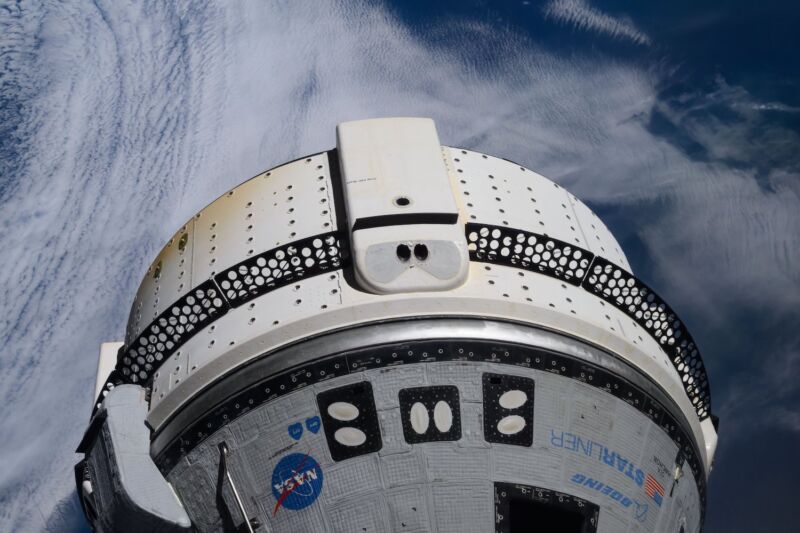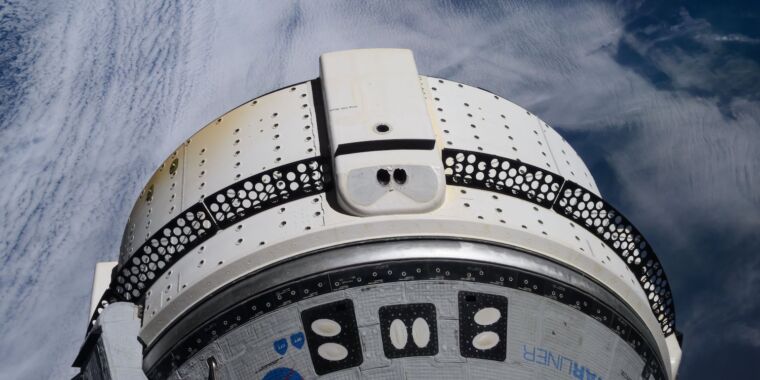
NASA
Boeing's Starliner spacecraft will slowly pull away from the International Space Station on Friday evening, then use its aggressive engines to quickly clear the vicinity of the space laboratory and its nine-person crew.
NASA asked Boeing to adjust Starliner's launch sequence so that the spacecraft could leave the space station more quickly and reduce the workload on the thrusters. This was to reduce the risk of overheating, which caused some of the thrusters to fail as the spacecraft approached the outer station for docking in June.
The action begins at 6:04 p.m. EDT (10:04 p.m. UTC) on Friday, when the hooks of the docking mechanism connecting Starliner to the International Space Station (ISS) open and springs yank the spacecraft free from its mooring at the front of the massive research complex.
About 90 seconds later, a set of forward-facing thrusters on Starliner’s service module will fire in a series of 12 pulses over a few minutes to propel the spacecraft farther away from the space station. These maneuvers will send Starliner on a trajectory over the top of the ISS, then behind it until it’s time for the spacecraft to perform a deorbit burn at 11:17 p.m. EDT (03:17 UTC) to land at White Sands Space Harbor, New Mexico, shortly after midnight EDT (10 p.m. local time at White Sands).
How to watch and what to look for
The two videos below show NASA TV's live broadcast of the Starliner undocking and landing.
Starliner is leaving its two-man crew behind on the space station after NASA officials last month decided they didn't have enough confidence in the spacecraft's reaction control system (RCS) thrusters, which are used to make precise changes to the capsule's trajectory and orientation in orbit. Five of the 28 RCS thrusters on Starliner's service module failed during the spacecraft's rendezvous with the space station three months ago. Subsequent investigations showed that overheating can cause Teflon seals in a poppet valve to swell, restricting the flow of fuel to the thrusters.
Engineers recovered four of the five thrusters after they temporarily stopped working, but NASA officials couldn’t be sure the thrusters wouldn’t overheat again on the return trip. NASA decided it was too risky for Starliner to return home with astronauts Butch Wilmore and Suni Williams, who launched on Boeing’s test flight June 5 and became the first people to fly in the commercial capsule. They will remain aboard the space station until February, when they will return to Earth aboard a SpaceX Dragon spacecraft.
The original flight plan, which had included Wilmore and Williams aboard the Starliner for the return trip, called for the spacecraft to depart the ISS more quietly so engineers could thoroughly check the performance of the navigation sensors and test the spacecraft's ability to loiter near the station for photographic inspections of its exterior.
“In this case, we're doing a breakout burn, which is a series of 12 burns, each not very large, about 0.1 meters per second (0.2 mph), and we're going to pull the Starliner away from the space station, and then it's going to go up and away immediately. It's going to eventually make a turn to the top and then leave the space station a couple of orbits later,” said Anthony Vareha, NASA's flight director who is overseeing ISS operations during Starliner's separation.
Astronauts won't be in the cockpit of the Starliner to take control in case of a major problem, so NASA managers want the spacecraft to leave the station as soon as possible.
On this path, Starliner will leave the so-called approach ellipsoid, a 2.5-by-1.25-by-1.25-mile (4-by-2-by-2-kilometer) invisible boundary around the orbital laboratory, about 20 to 25 minutes after undocking, NASA officials said. That's less than half the time it would normally take Starliner to leave the vicinity of the ISS.
“It's a quicker way to get away from the station, with less stress on the thrusters,” said Steve Stich, NASA's commercial crew program manager. “Essentially, once we open the hooks, the springs push Starliner away and then we do a couple of very short thruster discharges to put us on a trajectory that takes us above the station and behind it, we open up to a nice range where we can do the deorbit burn.”
Vareha said that in the unlikely event of a series of more serious thruster failures, the springs pushing the Starliner away from the space station should be enough to prevent a collision.
“After that, we're just going to be very cautious and not fire the thrusters at all,” Stich said.
Starliner will need to use its RCS thrusters again to point itself in the right direction to fire four larger rocket engines for the deorbit burn. Once this burn is complete, the RCS thrusters will reorient the spacecraft to jettison the service module for atmospheric burnup. The reusable crew module will rely on a separate set of thrusters during reentry.
Finally, the capsule will approach the landing zone in New Mexico from the southwest, flying over the Pacific Ocean and Mexico before deploying three main parachutes and airbags to soften the landing at White Sands. Boeing and NASA teams will rendezvous with the spacecraft there and secure it for a trip back to Kennedy Space Center in Florida for refurbishment.
Meanwhile, engineers must fix the root causes of the thruster problems and helium leaks that plagued the Starliner test flight before it can fly astronauts again.

